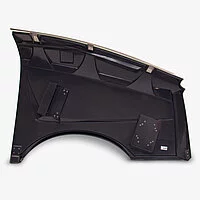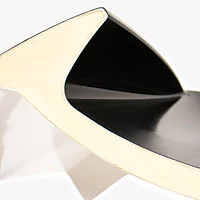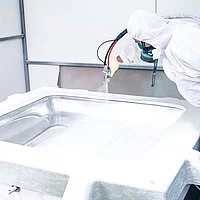The vacuum expansion process (VEX) is an innovative method for manufacturing components made of glass fiber reinforced plastic (GRP) in sandwich construction. This process combines glass fiber reinforcement and foamed polyester resins to produce lightweight yet durable components with high surface quality. C.F. Maier-TEC has extensive expertise in the development and application of the VEX process for the production of high-quality composite plastics.
Vacuum expansion process (VEX)





The VEX process
The VEX process combines glass fiber reinforcement with foamed synthetic resins to produce complex GRP moulded parts. Similar to the RTM process, the glass fiber mats are impregnated with polyester resin in the VEX process. This process takes place in a closed mold, which can be in two or more parts and is manufactured according to the C.F. Maier standard. This ensures high surface quality, dimensional accuracy and process reliability.
The manufacturing process of the VEX method begins with the application of a gelcoat top layer in the mold, followed by the insertion of the glass fiber reinforcement, supplemented by hard foam cores if necessary. If required, additional metal or wooden inserts, cables or empty conduits can be integrated into the sandwich parts to meet the specific requirements. The foamable polyester resin is then introduced into the open mold and the mold is closed. The vacuum supports the even distribution of the resin, creating a microcellular structural rigid foam that completely encases the fiber reinforcement and the inserts.
Variety of materials and areas of application
The VEX process results in components with smooth surfaces on both sides and high surface quality, whereby the outer and inner contours of the components can be different. After curing, the components are demolded and trimmed, milled and, if necessary, drilled on CNC milling machines. The use of gelcoat means that subsequent painting is optional. The surface and contour defined in the tool offer high precision, while the foamed resin enables a lightweight yet resilient component.
A major advantage of the VEX process is the production of large-area components with complex geometries. Vehicle fronts for motorhomes, for example, are ideal for this process, as there are virtually no limits to the design wishes of our customers. The sandwich parts can contain cut-to-size rigid foam cores or molded foam inserts, which are manufactured in-house to ensure optimum quality. Sandwich construction makes a significant contribution to improving the rigidity, thermal insulation and soundproofing of the components.
The option of integrating inserts such as cables and fixing points into the sandwich parts means that considerable savings can be made on assembly costs. In the case of the motorhome rear wall, for example, wiring for rear lights and license plate lighting can already be integrated during component manufacture, saving additional assembly hours.
Advantages and limitations of the VEX process
The VEX process offers many advantages for the production of lightweight but robust components with excellent surface quality. The tool costs for plastic tools are relatively low, which means that the process can be used economically for annual quantities of a few hundred parts or more. For larger productions, up to 10,000 parts per year, metal tools can be used in intermittent production processes.
The VEX process is similar to the VA-RTM process, but differs in that the resin is foamed in the VEX process, which reduces the overall density of the component. The result is lighter components with a high load-bearing capacity, which are particularly suitable for lightweight construction applications.
Summary of the advantages
The vacuum expansion process offers the following advantages:
- Lightweight and resilient components thanks to the combination of glass fiber reinforcement and foamed polyester resins
- High surface quality thanks to the closed process and the use of gelcoat
- Large-area components and complex geometries possible, ideal for vehicle components such as motorhome fronts
- Sandwich construction improves rigidity, heat and sound insulation
- Cost-efficient production thanks to low tooling costs and integration of inserts to reduce assembly costs
The VEX process is therefore a highly flexible and efficient method for manufacturing composite components that enables lightweight construction, design freedom and a high level of functional integration.
Would you like to find out more?
Send us an email or use our contact form or use our matchmaker for partnership and cooperation inquiries: